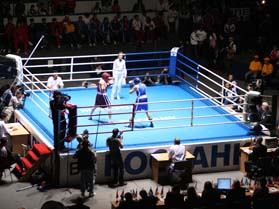
Ring: the center of the competition
The ring, the most visual equipment of a boxing event which focuses all eyes in the stadium is usually between 4.90 m square and 6.10 m square. The boxers representing red and blue corners compete on the ring, showing existing contesting, admirable hitting and defending. Four corners of the ring are arranged in the following way: the red corner which is the nearer left-side ring corner facing the Jury is opposite the blue corner; while other two are white and called neutral corners.
When you watch a boxing competition, you would not ignore the four fixed posts standing at each corner. Three or four ropes with 3-5 cm's diameter are tightly drawn from the posts so as to prevent the boxers from falling off the ring. For the same purpose the platform beyond the line of the ropes is at least 46 cm.
In order to become more stable, the ropes are joined on each side, at equal intervals, by two pieces of close textured canvas 3 to 4 cm wide. All ropes are covered with a soft or smooth material in case not to scrape boxers when they bump on the ropes intensively.
Boxing competitions have very strict demand for the competing infrastructures. The floor of the ring usually covered with felt or rubber should be smooth and secure, over which canvas should be stretched in place so that the boxers could move freely and use their technical skills. Boxers can not compete on the floor with uneven surfaces!
For international and other important championships, because of the number of participants, two rings are used. There is obvious difference between the sound of two bells of these rings to differentiate them and avoid disturbing interactions.
Other equipments including steps, seats, plastic bags (normally for referee to drop the cotton used to nurse bleedings) etc. are seen around the ring. All these equipments indicate the development of boxing and it is a concerted endeavour to make a success competition and a safe sport.
(BOCOG)